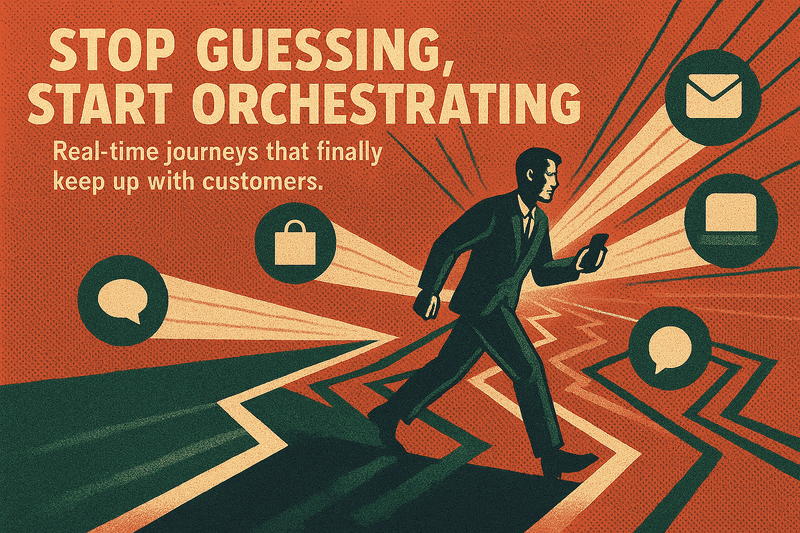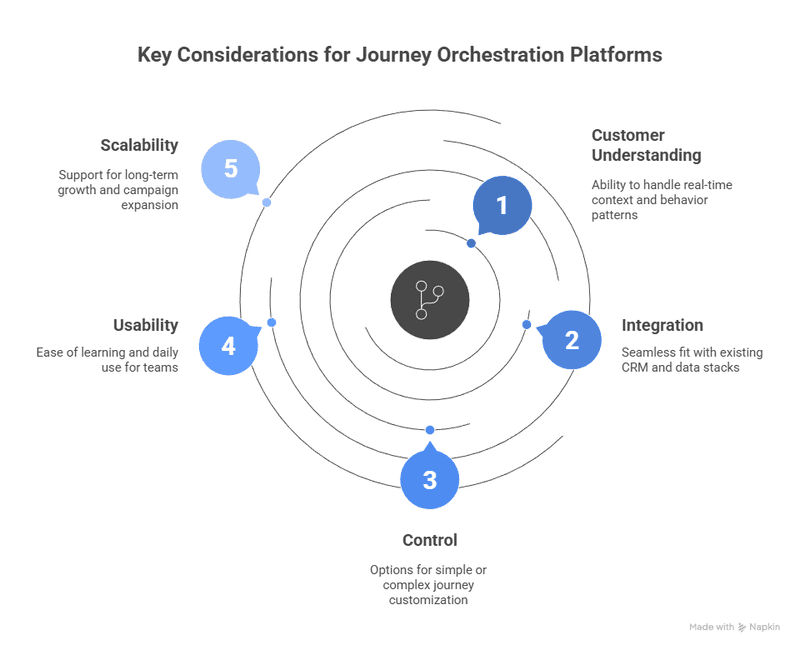Top Journey Orchestration Platforms in 2025 For Real-Time Customer Experiences

Customer journeys aren’t linear anymore, they’re living systems that react to every click, pause, and question. Journey orchestration is what keeps those moving parts connected.
Customer expectations have skyrocketed, and businesses can no longer rely on disconnected tools or static customer journey maps. The demand for top journey orchestration platforms has grown because brands need real-time, AI-driven systems that unify data, automate actions, and personalize interactions across every touchpoint. This guide breaks down the five best platforms redefining journey orchestration in 2025, helping teams automate journeys, eliminate data silos, and create more meaningful customer interactions.
What Is a Journey Orchestration Platform?
A journey orchestration platform (JOP) is a real-time system that connects customer data, identifies intent, and automates the next-best action across every channel. Unlike traditional journey mapping tools, which visualize but don’t execute, JOPs operate dynamically. They pull data from multiple sources, analyze behavior as it happens, and trigger personalized messages, offers, or workflows at the exact moment a customer needs them.
Modern platforms go beyond basic automation by integrating AI, predictive analytics, and omnichannel execution. This allows teams to remove data silos, respond instantly to customer behavior, and deliver consistent experiences across marketing, sales, product, and support.
Why Journey Orchestration Matters Today
The brands winning today aren’t the ones sending more messages, they’re the ones sensing intent in real time and responding with relevance.
Customers move quickly, and most brands struggle to keep up. People hop between channels, expect quick answers, and lose interest just as fast. Journey orchestration helps teams respond in the moment instead of scrambling after the fact.
You can think of it like a map that redraws itself as someone browses, clicks, or asks a question. The system picks up those signals and guides them forward in a way that feels natural. It also helps every teamwork from the same source of truth, which cuts down on mixed messages.
At its core, journey orchestration reduces guesswork. It pulls scattered data together and helps brands show up at the right time without overdoing it. In a world where attention slips fast, that bit of timing goes a long way.
How We Chose the Top Journey Orchestration Platforms in 2025
Deciding on a journey orchestration platform can feel a bit overwhelming, mostly because everything sounds promising at first glance. What matters more is how well the tool fits the way your team actually works.
What Brands Should Keep in Mind

How the platform understands your customers
Look at whether it handles real time context, behavior patterns, and signals that change quickly throughout the day.
How it fits into your existing setup
Some tools slide neatly into your CRM or data stack. Others need extra configuration before they feel natural.
How much control you want over your journeys
Simple drag and drop paths might be enough for some teams, while others need branching logic, decision points, and more expressive personalization.
How comfortable your teams will be using it daily
A tool that’s easy to learn and doesn’t slow people down usually wins in the long run, even if it’s not the flashiest option.
How well it supports your long term goals
Think about whether it can grow with your campaigns instead of forcing you to jump platforms again later.
A platform might be powerful, but if it takes a small army to run it, most teams won’t get far. The ones that made this list strike a good balance between capability and usability, which is a rare mix in this space.
Key Features to Evaluate in Customer Journey Orchestration Tools
When comparing customer journey management or journey orchestration software, a few capabilities matter more than anything else.
Unified Data Interface
Your platform should pull customer signals from every system into one place, a clean, real-time view instead of scattered data.
AI-Driven Automation
Look for predictive audiences, dynamic triggers, and automated decisioning that adapts journeys based on live behavior.
Omnichannel Execution
The tool should coordinate journeys across email, SMS, push, WhatsApp, and web without losing context.
Single Customer View (SCV)
Strong identity resolution ensures every interaction maps to the right individual, improving personalization and journey analytics.
Real-Time Journey Analytics
Beyond dashboards, you need insights that reveal drop-offs, intent shifts, conversion paths, and friction points.
User-Friendly, No-Code Journey Builder
A drag-and-drop interface helps teams design, test, and launch journeys workflows quickly without depending on developers or complex workflows.
1. Zigment
Zigment works from the belief that every customer interaction leaves a thread worth paying attention to. Most platforms only grab the clean, structured bits, but Zigment pulls in everything and stitches it into a single customer view that feels current, not frozen. Its conversation graph maps how people actually move through touchpoints, and because it listens to qualitative signals like tone, intent, and hesitation, the agentic AI can spot the next best action without teams wrestling with endless rules or complicated flows.
The orchestration layer is what ties it all together. Instead of asking you to rebuild your stack, Zigment sits neatly on top of what you already use. It cleans scattered data, feeds that unified SCV into every channel, and smooths out the rough edges so journeys don’t feel patched together. The end result is a system that guides customers with context and timing, rather than forcing them through a rigid sequence.
2. Insider
Insider is a cross-channel customer engagement platform built for hyper-personalization, offering AI-powered segmentation, predictive audiences, and coordinated journeys across web, mobile, email, and messaging apps. Its strength comes from combining deep behavioral insights with on-site and in-app experience tools, making it a strong choice for brands that want to craft individualized lifecycle journeys at scale. Teams may find that fully unlocking its advanced capabilities works best when they have the bandwidth for thoughtful setup and experimentation.
3.Braze
Braze excels in real-time customer engagement, leveraging behavioral triggers, dynamic segmentation, and mobile-first messaging across push, in-app, email, and SMS. It’s particularly strong at helping teams deliver timely messages that match user intent, supported by powerful APIs and experimentation options. Many brands pair Braze with strong upstream data systems to get the most from its real-time orchestration and personalization strengths.
4.Salesforce
Salesforce serves as a robust CRM and customer operations platform, unifying sales, marketing, and service workflows with extensive customization, powerful automation, and AI-driven insights through Einstein. It’s designed for scalability, making it a fit for organizations that need flexible data models and end-to-end operational alignment. Larger teams often dedicate resources to ongoing optimization so they can fully utilize Salesforce’s depth and ecosystem.
5.HubSpot
HubSpot offers an intuitive, all-in-one CRM with strong marketing, sales, and service capabilities, popular for its ease of adoption, clean interface, and native automation tools. It supports teams looking for a unified system that streamlines content, email, pipeline, and customer engagement tasks without heavy configuration. As businesses scale into more complex use cases, some choose to extend HubSpot with additional integrations or custom workflows to maintain that simplicity with greater sophistication.
Comparison of the Top Journey Orchestration Platforms
Platform | Suitable company size | Trial / Demo availability | Key features | AI / Automation | Channels supported | Ease of use | Integration nature | Scalability |
|---|---|---|---|---|---|---|---|---|
Zigment | SMB → Mid-market → Enterprise | Demo available | Real-time orchestration, conversation graph, event-based triggers, SCV, agentic actions | Context-aware automation, predictive actions (stated on website) | Email, SMS, WhatsApp, push, webhooks, CRM connectors | Marketer-friendly UI with no-code builder + advanced logic | API-first; integrates with CRMs, helpdesks, analytics tools | Designed for multi-system orchestration |
Insider | Mid-market → Enterprise | Demo / trial available | Predictive segmentation, on-site personalization, journey automation, CDP-like audience layer | Predictive segmentation, propensity models | Web, mobile, email, push, messaging apps | Generally easy for marketers; deeper features require setup | Many native integrations; CDP/CRM sync requires mapping | Strong digital scalability |
Braze | Mid-market → Enterprise | Demo; POC often available | Canvas journey builder, event-driven messaging, experiments, segmentation | ML personalization features, real-time triggers | Mobile push, in-app, email, SMS, webhooks | Canvas is intuitive; data setup requires technical involvement | Requires strong data pipelines; API-heavy | Extremely high (used by large-scale mobile apps) |
Salesforce Marketing Cloud | Mid-market → Enterprise | Demos and pilot evaluations | Journey Builder, CRM integration, audience management, enterprise workflows | Einstein AI for scoring, segmentation, predictions | Email, SMS (via Mobile Studio), push, advertising, service channels | Powerful but steep learning curve | Deep integrations via Salesforce ecosystem & APIs | Enterprise-grade scalability |
HubSpot | SMB → Mid-market | Free tier + trials on paid hubs | CRM + marketing automation, workflow builder, email tools, forms, segmentation | Basic predictive scoring & automation | Email, web, chat, limited SMS (via partners) | Very easy; designed for general marketing teams | Large integration marketplace; simple syncs | Good for SMB/mid-market volumes |

Final Thoughts on the Future of Journey Orchestration
As channels multiply and data scatters, the real advantage lies in platforms that can turn every interaction into a connected thread.
Journey orchestration is slowly shifting from a nice-to-have to something teams can’t really ignore anymore. Customers move around fast, and they expect brands to keep up without losing the plot. The whole industry seems to be drifting toward that idea of one connected customer thread instead of scattered touchpoints that never quite talk to each other.
Looking ahead, the real winners will be the platforms that pay attention. Not the loudest ones, but the ones that handle context well and make decisions in the moment without feeling mechanical. People don’t want more messages. They want moments that make sense. And that’s where orchestration is quietly heading.